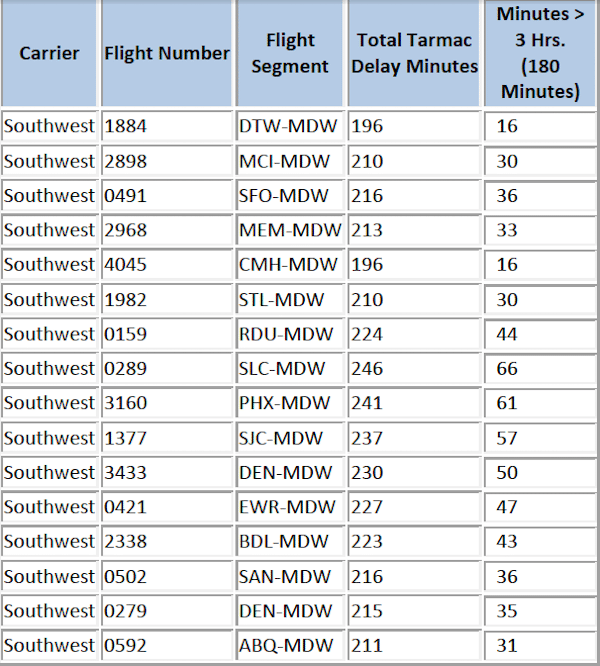Skift Take
Consumer advocates fought hard to get this tarmac delay rule in place. The airlines bitterly fought the rule and predicted the sky would fall if the tarmac delay rule went into effect. You can be sure that Southwest will ensure that it has adequate ramp staff on the job the next time one of these big snowstorms comes around.
The U.S. Department of Transportation tagged Southwest with a $1.6 million tarmac delay penalty, the DOT’s largest penalty since the rule went into effect in 2009.
The DOT’s Aviation Enforcement Office pointed to 16 Southwest flights at Chicago Midway from January 2 to 3, 2014 that were held on the tarmac for longer than three hours, and the airline did not give passengers the option to deplane, as is passengers’ right.
The area was hit with 12.3 inches of snow from December 31, 2013 to January 2, 2014, although the airport’s two main runways “remained open and operational,” the DOT found.
“The absence of some of Southwest’s ramp crew inhibited the carrier’s ability to clear aircraft from Southwest’s gates in a timely manner to accommodate arriving flights,” the consent order states. “At the time the sixteen flights at issue arrived at MDW, between 10:15 p.m. and 11:01 p.m., an employee shift change had taken place and the small ramp crew that remained made it impossible for Southwest to clear and prepare gates for the arriving flights in a timely manner. The Enforcement Office is not disputing, nor is this order based upon, Southwest’s assertion that it could not safely deplane passengers at that time.”
As the table below shows, of the 16 flights that exceeded the tarmac delay rule’s three-hour limit, two were delayed more than four hours.
Source: DOT
“Southwest states that on January 2nd, its employees worked tirelessly to get the 16 affected flights to the gate as soon as possible, but ultimately, their efforts fell short,” the consent order states. “Southwest notes, however, that the cabin crews on the affected flights ensured that passengers were provided with the services required by the tarmac delay rule such as food, water, announcements, functional lavatories, and medical attention as needed. Southwest states that on January 3, 2014, it proactively sent each of the affected passengers a message of apology and a Southwest LUV Voucher for future travel.”
Southwest was fined for failing to offer passengers the right to deplane when it hit the three-hour tarmac delay limit and for failing to have adequate ramp crew in place to implement contingency plans.
In negotaitions over the penalty, Southwest disagreed with the DOT’s interpretation of the tarmac delay rule that penalties are to be handed out on a $27,500 per passenger basis. Southwest argued that the penalty should be levied on either a per-day per-flight basis, but agreed to the compromise settlement to avoid litigation, according to the DOT.
The highest tarmac delay fine previously levied against United for $1.1 million for tarmac delays in 2012. The DOT has issued 17 tarmac delay penalties against airlines — including this fine against Southwest — since the rule became effective in 2009.
The DOT states that Southwest’s fine was larger than United’s because the tarmac delays affected more flights and passengers.
The Daily Newsletter
Our daily coverage of the global travel industry. Written by editors and analysts from across Skift’s brands.
Have a confidential tip for Skift? Get in touch
Tags: dot, southwest airlines, tarmac delays
Photo credit: The DOT fined Southwest for tarmac delays that occurred in early January 2014. Pictured, Southwest Airlines employees guide a plane into the gate at Midway International Airport in Chicago, Illinois, on February 26, 2013. Armando L. Sanchez / Chicago Tribune/MCT
